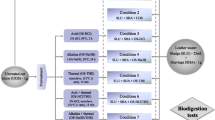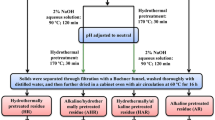Abstract
Lignocellulosic biomass is considered as a recalcitrant substrate for anaerobic digestion due to its complex nature that limits its biological degradation. Therefore, suitable preprocessing for the improvement of the performance of conventional anaerobic digestion remains a challenge in the development of anaerobic digestion technology. The physical and chemical characteristics of wheat straw (WS), as a representative lignocellulosic biomass, have a significant impact on the anaerobic digestion process in terms of quantity and quality of the produced biogas. This study aimed at investigating the enzymatic saccharification and detoxification of straw prior to anaerobic digestion with the final objective of enhancing the performance of conventional anaerobic systems of recalcitrant fractions of agricultural waste. The experimental activity was performed in lab and pilot scale treating WS. Alkaline delignification of straw using sodium hydroxide (NaOH) was studied prior to enzymatic hydrolysis for the production of easily biodegradable sugars. After defining the optimum conditions for the pretreatment scheme, the anaerobic digestability of the effluents produced was measured. Finally, the final liquid effluents were fed to a pilot scale anaerobic digester of 0.5 m3 volume, applying an increasing organic loading rate (OLR) regime (in terms of chemical oxygen demand (COD) from 0.2 to 15 kg COD/m3/day). The optimum conditions for the delignification and enzymatic hydrolysis of WS were defined as 0.5 M NaOH at 50 °C for 3–5 h and 15 μL Cellic CTec2/g pretreated straw at 50 °C. It was proven that the resulting liquid effluents could be fed to an anaerobic digester in the ratio that they are produced with satisfactory COD removal efficiencies (over 70%) for OLRs up to 10 kg COD/m3/day. This value is correspondent to a hydraulic retention time of around 7.5 days, much lower than the respective one for untreated straw (over 12 days).








Similar content being viewed by others
References
Al-Battashi HS, Annamalai N, Sivakumar N, Al-Bahry S, Tripathi BN, Nguyen QD, Gupta VK (2019) Lignocellulosic biomass (LCB): a potential alternative biorefinery feedstock for polyhydroxyalkanoates production. Rev Environ Sci Biotechnol 18:183–205. https://doi.org/10.1007/s11157-018-09488-4
Angelidaki I, Alves M, Bolzonella D, Borzacconi L, Campos JL, Guwy AJ, Kalyuzhnyi S, Jenicek P, Van Lier JB (2009) Defining the biomethane potential (BMP) of solid organic wastes and energy crops: a proposed protocol for batch assays. Water Sci Technol 59:927–934. https://doi.org/10.2166/wst.2009.040
APHA, AWWA W (2005) APHA, standard methods for the examination of water and wastewater, American Public Health Association. Am Public Heal Assoc Washingt
Barakat A, Monlau F, Solhy A, Carrere H (2015) Mechanical dissociation and fragmentation of lignocellulosic biomass: effect of initial moisture, biochemical and structural proprieties on energy requirement. Appl Energy 142:240–246. https://doi.org/10.1016/j.apenergy.2014.12.076
Bolado-Rodríguez S, Toquero C, Martín-Juárez J, Travaini R, García-Encina PA (2016) Effect of thermal, acid, alkaline and alkaline-peroxide pretreatments on the biochemical methane potential and kinetics of the anaerobic digestion of wheat straw and sugarcane bagasse. Bioresour Technol 201:182–190
Chandra R, Takeuchi H, Hasegawa T (2012a) Hydrothermal pretreatment of rice straw biomass: a potential and promising method for enhanced methane production. Appl Energy 94:129–140. https://doi.org/10.1016/j.apenergy.2012.01.027
Chandra R, Takeuchi H, Hasegawa T (2012b) Methane production from lignocellulosic agricultural crop wastes: a review in context to second generation of biofuel production. Renew Sust Energ Rev 16:1462–1476. https://doi.org/10.1016/j.rser.2011.11.035
Chandra R, Takeuchi H, Hasegawa T, Kumar R (2012c) Improving biodegradability and biogas production of wheat straw substrates using sodium hydroxide and hydrothermal pretreatments. Energy 43:273–282. https://doi.org/10.1016/j.energy.2012.04.029
De Francisci D, Kougias PG, Treu L, Campanaro S, Angelidaki I (2015) Microbial diversity and dynamicity of biogas reactors due to radical changes of feedstock composition. Bioresour Technol 176:56–64. https://doi.org/10.1016/j.biortech.2014.10.126
Dey P, Pal P, Kevin JD, Das DB (2020) Lignocellulosic bioethanol production: prospects of emerging membrane technologies to improve the process - a critical review. Rev Chem Eng 36:333–367. https://doi.org/10.1515/revce-2018-0014
Esposito G, Frunzo L, Liotta F, Panico A, Pirrozzi F (2012) Bio-methane potential tests to measure the biogas production from the digestion and co-digestion of complex organic substrates. Open Environ Eng J 5:1–8. https://doi.org/10.2174/1874829501205010001
Feng L, Qin L, Liu ZH, Dong CY, Li BZ, Yuan YJ (2014) Combined severity during pretreatment chemical and temperature on the saccharification of wheat straw using acids and alkalis of differing strength. BioResources 9:24–38. https://doi.org/10.15376/biores.9.1.24-38
Feng L, Moset V, Li W, Chen C, Møller HB (2017) In-situ injection of potassium hydroxide into briquetted wheat straw and meadow grass – effect on biomethane production. Bioresour Technol 239:258–265. https://doi.org/10.1016/j.biortech.2017.05.032
Fischer-Kowalski M, Swilling M, von Weizsäcker EU, Ren Y, Moriguchi Y, Crane W, Krausmann, F. Eisenmenger N, Giljum S, Hennicke P, Romero Lankao P, Siriban Manalang A (2011) Decoupling natural resource use and environmental impacts from economic growth. A Report of the Working Group on Decoupling to the International Resource Panel
Gontard N, Sonesson U, Birkved M, Majone M, Bolzonella D, Celli A, Angellier-Coussy H, Jang GW, Verniquet A, Broeze J, Schaer B, Batista AP, Sebok A (2018) A research challenge vision regarding management of agricultural waste in a circular bio-based economy. Crit Rev Environ Sci Technol 48:614–654. https://doi.org/10.1080/10643389.2018.1471957
Guillard V, Gaucel S, Fornaciari C, Angellier-Coussy H, Buche P, Gontard N (2018) The next generation of sustainable food packaging to preserve our environment in a circular economy context. Front Nutr 5:1–13. https://doi.org/10.3389/fnut.2018.00121
Kontogianni N, Barampouti EM, Mai S, Malamis D, Loizidou M (2019) Effect of alkaline pretreatments on the enzymatic hydrolysis of wheat straw. Environ Sci Pollut Res 26:35648–35656. https://doi.org/10.1007/s11356-019-06822-3
Kumar P, Barrett DM, Delwiche MJ, Stroeve P (2009) Methods for pretreatment of lignocellulosic biomass for efficient hydrolysis and biofuel production. Ind Eng Chem Res 48:3713–3729. https://doi.org/10.1021/ie801542g
Li L, Chen C, Zhang R, He Y, Wang W, Liu G (2015a) Pretreatment of corn stover for methane production with the combination of potassium hydroxide and calcium hydroxide. Energy and Fuels 29:5841–5846. https://doi.org/10.1021/acs.energyfuels.5b01170
Li Y, Merrettig-Bruns U, Strauch S, Kabasci S, Chen H (2015b) Optimization of ammonia pretreatment of wheat straw for biogas production. J Chem Technol Biotechnol 90:130–138. https://doi.org/10.1002/jctb.4297
Liu X, Zicari SM, Liu G, Li Y, Zhang R (2015) Pretreatment of wheat straw with potassium hydroxide for increasing enzymatic and microbial degradability. Bioresour Technol 185:150–157. https://doi.org/10.1016/j.biortech.2015.02.047
Sambusiti C, Monlau F, Ficara E, Carrère H, Malpei F (2013) A comparison of different pre-treatments to increase methane production from two agricultural substrates. Appl Energy 104:62–70. https://doi.org/10.1016/j.apenergy.2012.10.060
Sluiter A, Hames B, Ruiz R, Scarlata C, Sluiter J, Templeton D, Crocker D (2012) Determination of structural carbohydrates and lignin in biomass: laboratory analytical procedure (LAP) (NREL/TP-510-42618). Natl Renew Energy Lab 17. NREL/TP-510-42618
Smit AT, Huijgen WJJ (2017) The promotional effect of water-soluble extractives on the enzymatic cellulose hydrolysis of pretreated wheat straw. Bioresour Technol 243:994–999. https://doi.org/10.1016/j.biortech.2017.07.072
Solé-Bundó M, Eskicioglu C, Garfí M, Carrère H, Ferrer I (2017) Anaerobic co-digestion of microalgal biomass and wheat straw with and without thermo-alkaline pretreatment. Bioresour Technol 237:89–98. https://doi.org/10.1016/j.biortech.2017.03.151
Vasmara C, Cianchetta S, Marchetti R, Galletti S (2017) Biogas production from wheat straw pre-treated with hydrolytic enzymes or sodium hydroxide. Environ Eng Manag J 16:1827–1836. https://doi.org/10.30638/eemj.2017.199
Wu Y, Kovalovszki A, Pan J, Lin C, Liu H, Duan N, Angelidaki I (2019) Early warning indicators for mesophilic anaerobic digestion of corn stalk: a combined experimental and simulation approach. Biotechnol Biofuels 12:1–15. https://doi.org/10.1186/s13068-019-1442-7
Xu N, Liu S, Xin F, Zhou J, Jia H, Xu J, Jiang M, Dong W (2019) Biomethane production from lignocellulose: biomass recalcitrance and its impacts on anaerobic digestion. Front Bioeng Biotechnol 7:1–12. https://doi.org/10.3389/fbioe.2019.00191
Zhao Y, Wang Y, Zhu JY, Ragauskas A, Deng Y (2008) Enhanced enzymatic hydrolysis of spruce by alkaline pretreatment at low temperature. Biotechnol Bioeng 99:1320–1328. https://doi.org/10.1002/bit.21712
Funding
The authors acknowledge funding through European Horizon 2020 NoAW (No Agro Waste, Grant no. 688338) project for supporting this work.
Author information
Authors and Affiliations
Corresponding author
Additional information
Responsible editor: Ta Yeong Wu
Publisher’s note
Springer Nature remains neutral with regard to jurisdictional claims in published maps and institutional affiliations.
Rights and permissions
About this article
Cite this article
Novakovic, J., Kontogianni, N., Barampouti, E.M. et al. Towards upscaling the valorization of wheat straw residues: alkaline pretreatment using sodium hydroxide, enzymatic hydrolysis and biogas production. Environ Sci Pollut Res 28, 24486–24498 (2021). https://doi.org/10.1007/s11356-020-08905-y
Received:
Accepted:
Published:
Issue Date:
DOI: https://doi.org/10.1007/s11356-020-08905-y




